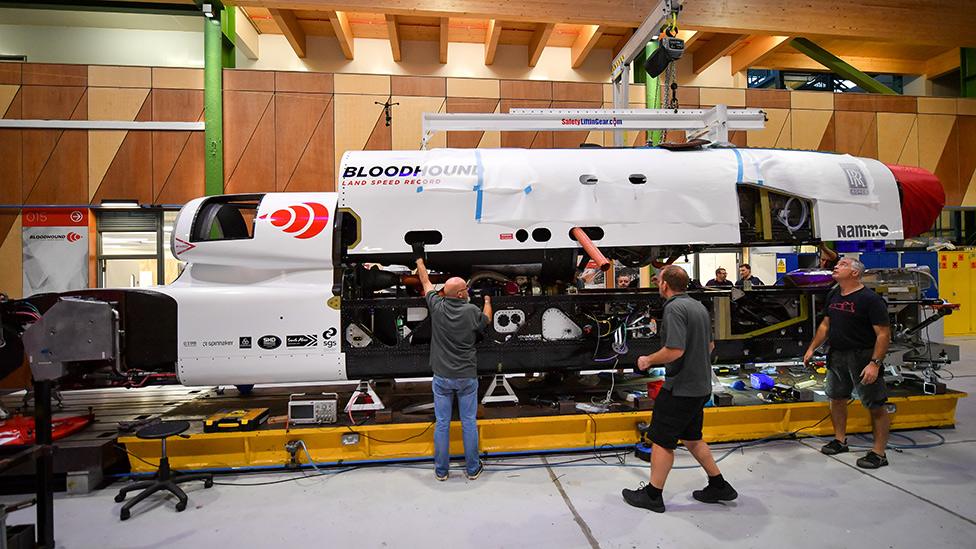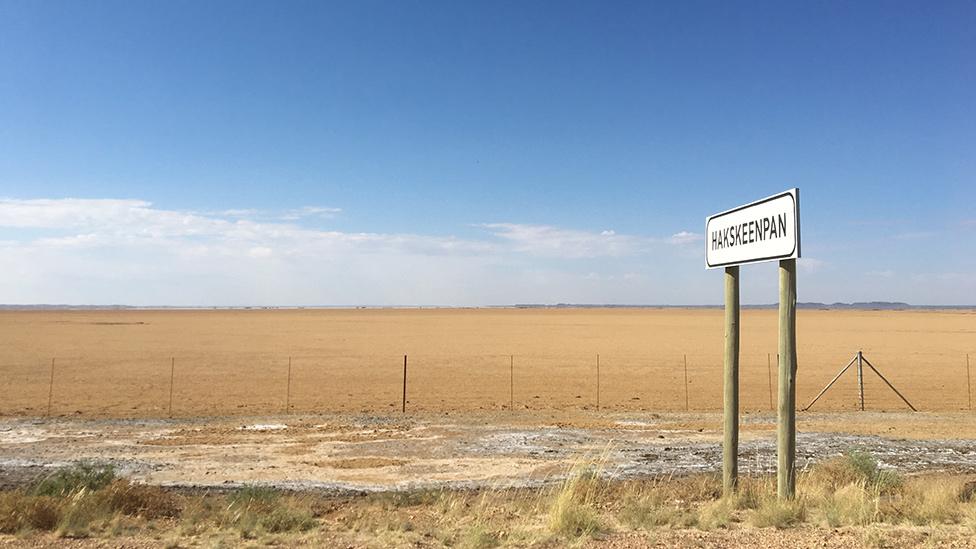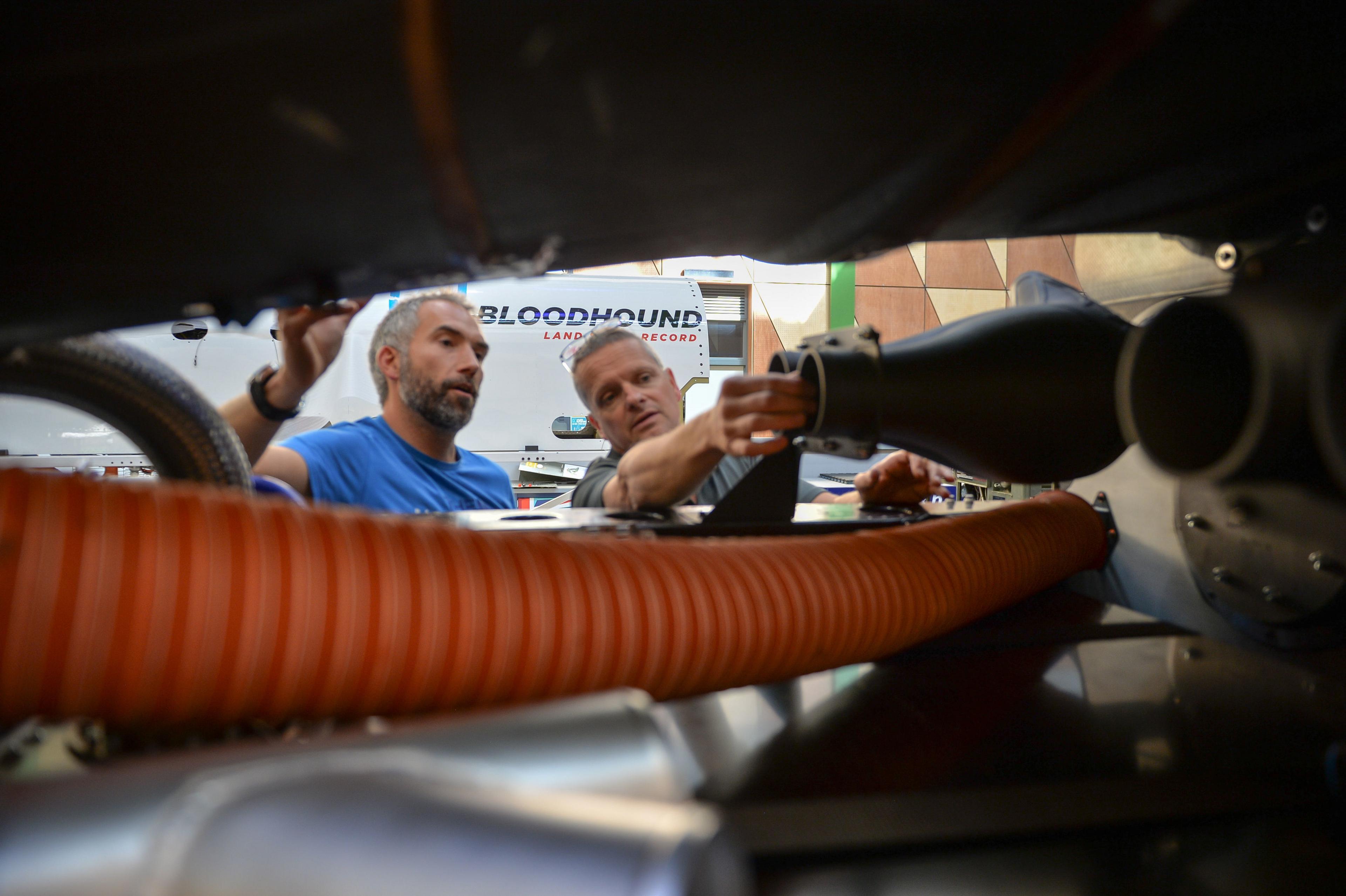Bloodhound supersonic car set for high-speed trials
- Published
BBC Points West's Steve Knibbs reports from the Bloodhound technical centre in Gloucestershire
The British-led Bloodhound supersonic car is virtually ready to start its high-speed trials.
The vehicle is due to leave its Gloucestershire base in the next fortnight to be air freighted to South Africa's Northern Cape.
Bloodhound, external has been built to break the existing land speed record of 763mph (1,228km/h).
However, engineers want first to validate their design assumptions with a series of sub-sonic runs.
These will see the car thunder across a dried-out lakebed called Hakskeen Pan at no more than 500-600mph, using just a jet engine taken from a Eurofighter-Typhoon.
Assuming no major problems are encountered, the team will then return to the Northern Cape in 12-18 months' time with a rocket motor also mounted in the vehicle. This extra thrust should enable Bloodhound to pierce the sound barrier (expected at around 755mph) and accelerate to over 800mph.
Mark Chapman: "We'll pretty rapidly build up the speeds to 400 and 500mph"
Monday saw engineers perform a "dry crank" on Bloodhound.
This involved blowing a high-pressure stream of air into its onboard Aircraft Mounted Accessories Drive (AMAD) gearbox, which in turn spun up the jet's turbine to the required starting speed and also began generating power for the car.
Ordinarily, the next step would be to flick switches in the cockpit to engage the fuel pumps and igniters, and fire up the Eurofighter power unit. But the dry crank was sufficient to tell the team that the jet engine and all its ancillary systems were correctly installed.
When the driver, Wing Commander Andy Green, "turns the key" on Hakskeen Pan, the Bloodhound car will roar to life.
The coming weeks are a critical test for the project that has spent more than a decade working on the most sophisticated land speed record car ever developed.
Bloodhound has done some low-speed trials (200mph) but it's only by going to progressively faster speeds that the team will know if the computer models used to describe the vehicle's anticipated behaviour and performance are correct.

Bloodhound will probe in a stepwise fashion the 300-500 mph window.
It's in this zone that the stability of the car will transition from being governed by the interaction of the wheels with the lakebed surface to being controlled by the vehicle's aerodynamics.
The grip from the wheels will fade faster than the aerodynamic forces build up. It's the window in which Andy Green may well find the car at its least stable.
"Below about 400mph, the front wheels steer the car just like they do on your car. But above 400-450mph, the wheels start to work like rudders and it's the aerodynamic forces on the wheels that's doing the steering," said chief engineer Mark Chapman.
The team is uncertain quite how fast Bloodhound will go during the trials. But with the Rolls-Royce-designed jet engine producing nine tonnes of thrust (90 kN), it should be possible to get the 13m-long, arrow-shaped Bloodhound above 600mph. This would certainly put it in the top 10 fastest cars in history with even greater performance yet to come.

The high-speed trials will take place on Hakskeen Pan, a dried-out lakebed in Northern Cape
The endeavour is not without risk, as evidenced by Jessi Combs' fatal accident in August. The popular TV personality and racer died as she tried to break the women's land speed record on Oregon's Alvord Desert. Her North American Eagle jet car crashed towards the end of a 500mph+ run.
"The land speed record community is a small one and although we're 'rivals' we all know each other and share information, and we've stated our support for [the North American Eagle team]. We have a different car, a different set-up and will be running on a different desert. But of course we did go through with them what happened to see if there was anything we could learn," Mr Chapman explained.
The Hakskeen trials are only happening because of the financial intervention of Yorkshire businessman Ian Warhurst. He rescued Bloodhound from collapse earlier this year and is underwriting the four to six-week programme.
He won't say precisely how much he's put into Bloodhound; "seven figures" is what he tells journalists. But he believes every penny to be worth it.
Mr Warhurst moved the project to the Berkeley Green University Technical College, external next to the Bristol Channel when he took over and has witnessed the enthusiasm of its students.
"Bloodhound's a really interesting project and just being here at the college to see what it does for the education side of things. We need more engineers in this country and these are the sort of projects that get people interested in engineering. The more engineers we get, the more problems we can solve in the future."

Jonathan.Amos-INTERNET@bbc.co.uk, external and follow me on Twitter: @BBCAmos, external